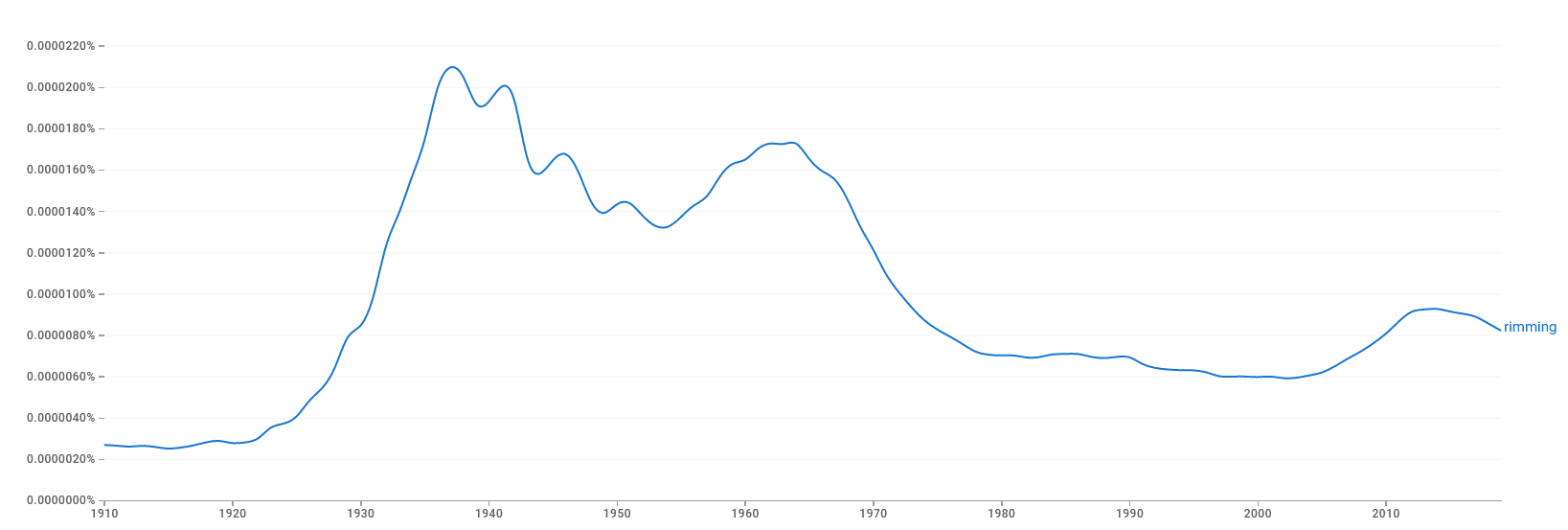![How Common is Rimming [Facts & Figures]](https://wp.bedbible.com/wp-content/uploads/2024/04/How-common-is-rimming-and-analingus.png)
Delve into the unexpected world of analingus/rimming with our report. This report offers a straightforward, easy-to-understand look at the statistics behind this intimate practice. Uncover the facts and figures that reveal its surprising prevalence in today’s society. Whether you’re driven by curiosity or seeking knowledge, our report sheds light on this often hidden aspect of sexuality. Get ready to be informed and perhaps even a bit surprised!
Table of contents:
- Studies on Analingus
- How Popular is Analingus in Writing?
- Online Search Trends
- Definition of Analingus / Anal Rimming
- Safety During Rimming
Key Findings
- 26.6% of women have received rimming whereas only 12.6% of men have received it.
- Rim jobs are a sexual activity that is becoming more and more popular.
- People who have anal sex are more likely to give or receive analingus.
- About 1 in 4 (24%) who’ve had anal sex said they’ve been given analingus in the last month.
- Around 1 in 7 (15%) who’ve had anal sex said they’ve received analingus in the last month.
- If people haven’t had anal sex, they’re much less likely to give or receive analingus (about 1 in 25 (4%) gave and 1 in 50 (2%) received it).
- Those who’ve had anal sex and practice analingus do it quite often, roughly 7 times giving and 5 times receiving in the last month.
Studies on Analingus
Study 1
In a study from 2008 (Only peer-reviewed and released in 2010), it was found that 18% of men reported having engaged in anal sex, while 15% reported receiving analingus, and a significant 24% reported performing analingus.
Among men who had not engaged in anal intercourse, other forms of anal play were notably less common. Specifically, only 2% of heterosexual men who had not had penetrative anal sex reported performing analingus, 4% reported receiving analingus, 3% had experienced finger penetration during anal play, and 10% had provided finger-penetrative anal play.
The data can be found in the two tables below from the study:
Table 1. Anal Sexual Behaviors in the Past 30 Days by Lifetime History of Insertive Heterosexual Penile–Anal Sex (N = 1,478)
| Question about anal sex | Yes (n = 266), % | No (n = 1,212), % |
|---|---|---|
| Anal insertive intercourse | 18 | – |
| Inserted finger in partner’s anus | 53 | 10 |
| Received finger in anus | 24 | 3 |
| Placed mouth on partner’s anus | 24 | 4 |
| Received mouth on anus | 15 | 2 |
- Among those who reported a history of insertive penile-anal sex (n = 266):
- 18% reported engaging in anal insertive intercourse in the past 30 days.
- 53% reported inserting a finger in their partner’s anus.
- 24% reported receiving a finger in their anus.
- 24% reported placing their mouth on their partner’s anus (analingus).
- 15% reported receiving mouth on their anus (receiving analingus).
- Among those with no history of insertive penile-anal sex (n = 1,212):
- No anal insertive intercourse was reported.
- 10% reported inserting a finger in their partner’s anus.
- 3% reported receiving a finger in their anus.
- 4% reported placing their mouth on their partner’s anus (analingus).
- 2% reported receiving mouth on their anus (receiving analingus).
The second table:
Table 2. Mean Number of Times the Behavior was Performed in Past 30 Days by Lifetime History of Insertive Heterosexual Anal Sex (N = 1,478)
| Number of times by type of anal sex | Yes (n = 266), Mean | No (n = 1,212), Mean |
|---|---|---|
| Anal insertive intercourse | 4.6 | — |
| Inserted finger in partner’s anus | 6.99 | 3.75 |
| Received finger in anus | 5.56 | 3.62 |
| Received finger in the anus | 6.9 | 3.75 |
| Received mouth on anus | 5.52 | 4.29 |
- Among those who reported a history of insertive penile-anal sex (n = 266):
- Anal insertive intercourse was performed on average 4.6 times.
- A finger was inserted in their partner’s anus on average 6.99 times.
- Received a finger in their anus on average 5.56 times.
- Placed their mouth on their partner’s anus (analingus) on average 6.9 times.
- Received mouth on their anus (receiving analingus) on average 5.52 times.
- Among those with no history of insertive penile-anal sex (n = 1,212):
- No anal insertive intercourse was reported.
- A finger was inserted in their partner’s anus on average 3.75 times.
- Received a finger in their anus on average 3.62 times.
- Placed their mouth on their partner’s anus (analingus) on average 3.75 times.
- Received mouth on their anus (receiving analingus) on average 4.29 times.
If you’re interested in more anal sex statistics then take a look at our in-depth report here.
Study 2
This study, conducted at the Melbourne Sexual Health Centre in 2019, surveyed 709 heterosexual individuals about their sexual practices. Key findings include: 95.5% had vaginal sex in the past three months, with 50.1% reporting condomless encounters; 19% engaged in anal sex, with 63.5% having unprotected anal sex; oral sex was received by 89.8% of participants, with a higher incidence of women performing oral sex compared to men; 26.6% of women and 12.6% of men received rimming, while 25.5% of men and 9.3% of women performed it. The study found a significant association between age (35+ years) and the likelihood of engaging in anal sex and rimming. This research emphasizes the need to consider extragenital testing based on these sexual behaviors.
How Popular is Analingus in Writing?
If we look at how frequently the word “analingus” appears in books, scientific studies, and online writing we find that it has been on the rise since the early 1900s up until 1990. After 1990 to 1992-93 the frequency of the word analingus being used in writing dropped dramatically. It then started to increase again until around 2010 and has now dropped to former levels known from the 1980s to the 1990s. The data can be seen in the graph below:

A similar pattern can be found for the word “rimming” in texts throughout the years.

Or, the word “rim job”, which albeit somewhat similar in recent years, did see a much later spike in popularity:

Online Search Trends
We also looked into the popularity of the three most famous words for analingus (rimming, or rim job).
We looked at data from Google Trends, which showed the relative frequency of how much a given keyword has been searched on the Google Search Engine:
Analingus search trends
“Analingus” has become increasingly less popular from 2004 until today.

Rimming search trends
“Rimming” is a search that was on the decline from 2004 until 2009 but then has seen an increase in popularity to today.

Rim job popularity
“Rim job” is a super popular search term, which saw a massive spike in popularity around 2015 to 2016.

Definition of Analingus / Anal Rimming
Analingus, also known as rimming or a rim job, refers to the act of using the mouth and tongue to stimulate the anus. In other words, it is a sexual practice involving oral-to-anal contact. A form of oral-anal sex. It is therefore also a form of sexual activity that people of all sexual orientations and genders can enjoy.
What it involves: Analingus involves using the mouth, lips, tongue, and sometimes teeth to stimulate the anus and the surrounding area. This can involve licking, sucking, kissing, or gently nibbling.
Potential for pleasure: The anus and surrounding area are packed with nerve endings, making them highly sensitive. Many people find analingus pleasurable because of this sensitivity.
Safety During Rimming
Hygiene and safety are of paramount importance when engaging in analingus, or any form of sexual activity. Here are some key points to consider, backed by scientific data:
- Cleaning: Thorough cleaning of the anal area before analingus is essential. This can be done with mild, non-fragrant soap and warm water. Some people prefer to use an anal douche for deeper cleaning, but it’s not a requirement.
- Barrier Methods: Using barrier methods, such as dental dams, can significantly reduce the risk of spreading sexually transmitted infections (STIs). According to a study by the Centers for Disease Control and Prevention (CDC), using barrier methods can reduce the transmission risk of most STIs by approximately 50% (Herbenick et al., 2013).
- STI Transmission: It’s important to note that analingus can transmit STIs. Human papillomavirus (HPV), gonorrhea, syphilis, herpes, and even HIV can be transmitted through oral-anal contact. According to the World Health Organization (WHO), about 10% of STI cases globally are attributable to oral sex, which includes analingus (Chow et al., 2019).
- Vaccinations: Getting vaccinated for hepatitis A and B, and HPV can provide additional protection, as these diseases can be transmitted through analingus.
- Regular STI Testing: Regular STI testing is recommended for anyone sexually active, especially for those engaging in activities such as analingus. According to the CDC, only about 50% of people who should be screened receive recommended STI testing services.
- E. Coli and Other Bacteria: Analingus can potentially spread E. coli and other bacteria found in fecal matter, which can lead to infections. A study by the Journal of Infectious Diseases found that oral-anal contact was significantly associated with E. coli urinary tract infections in women (Cope et al., 2017).
Remember, maintaining good hygiene and taking safety precautions can help ensure a more enjoyable and healthy sexual experience. Open communication about sexual health with your partner is also key.
Sources
- Herbenick, D. et al. (2013). Sexual Behavior in the United States: Results from a National Probability Sample of Men and Women Ages 14–94. The Journal of Sexual Medicine, 7(Suppl 5), 255–265.
- Chow, E. P. F. et al. (2019). Global Estimates of the Prevalence and Incidence of Four Curable Sexually Transmitted Infections in 2016 Based on Systematic Review and Global Reporting. PLOS ONE.
- Cope, J. R. et al. (2017). Risk Factors for Urinary Tract Infections Caused by E. Coli in Women in the Postmenopausal Period. Journal of Infectious Diseases, 216(5), 604–610.
- Oral, Vaginal and Anal Sexual Practices among Heterosexual Males and Females Attending a Sexual Health Clinic: A Cross-Sectional Survey in Melbourne, Australia
